Use 'Print preview' to check the number of pages and printer settings.
Print functionality varies between browsers.
Printable page generated Thursday, 20 November 2025, 5:13 PM
Health Education, Advocacy and Community Mobilisation: 5. Human Behaviour and Health: 2
Study Session 5 Human Behaviour and Health: 2
Introduction
In the last study session you learnt about the main determinants of human behaviour and how to utilise this knowledge in your day to day health education activities. This session will help you look at some of the ways that people consider health and illness. The Health Belief Model and the theory of Diffusion of Innovations and their application in your health education activities will also be discussed.
Learning Outcomes for Study Session 5
When you have studied this session, you should be able to:
5.1 Define and use correctly all of the key words printed in bold. (SAQs 5.1, 5.2 and 5.5)
5.2 Discuss some of the important perspectives of human behaviour in relation to health, illness, sickness and disease. (SAQ 5.1)
5.3 Discuss various different explanations of illness and their role in influencing people’s health-seeking behaviour. (SAQ 5.2)
5.4 Explain the application of the Health Belief Model (HBM). (SAQ 5.3)
5.5 Explain the application of the theory of the Diffusion of Innovation model in health education. (SAQs 5.4 and 5.5)
5.1 Perspectives on health and illness
Disease, illness and sickness are all negative notions reflecting negative occurrences in human life. Disease calls for action by health workers who will be asked to identify and treat the occurrence – and then care for the person who has the disease. Illness changes the actions of the individual, making him or her communicate their personal perspective of the negative occurrence to others, for example by calling for help.
Disease is usually considered to be independent of subjective opinion and is objectively measurable through various medical tests. Illness, however, is the subjective feeling of the individual. These feelings are often referred to as symptoms, and ‘illness’ can only be indirectly accessed through the individual’s reports. ‘Sickness’ is a social identity as a result of the poor health of an individual defined by others with reference to the activity of that individual. Sickness in this sense is a social phenomenon. Sickness is assessed by measuring levels of performance with reference to expected social activities when these levels fail to meet social standards.
Disease, illness, and sickness are notions reflecting negative occurrences in human life. Their major difference is based on who perceives these negative occurrences. What do you think are the major features of each condition?
Disease is a negative bodily occurrence that is usually determined or confirmed by health workers. Illness is a negative bodily occurrence that is decided by the person themselves. Sickness is a negative bodily occurrence as determined by society or its institutions. And of course there is often overlap: people can have a disease, feel ill and be perceived as sick by others (Figure 5.1).
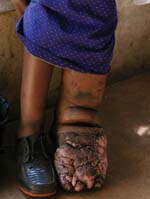
5.2 Explanations of illness
Most people consider that disease is a defined pathological condition of the body, whereas illness is a feeling of not being normal and healthy. Illness may, in fact, be due to a disease. However, it may also be due to a feeling of psychological or spiritual imbalance. By definition, perceptions of illness are highly culture-related, while disease usually is not.
For example, someone might feel ill after visiting a certain village where they believe that there are individuals with the evil eye. This is mainly due to the feeling that the individual has of not being normal and healthy. This is one example of illness. But if the individual goes to a health centre for treatment the nurse may not find any sign of a disease — and the person may be sent back home just with reassurance. That means that there is no diagnosed disease present in the individual, but they may still feel ill.
It is important for health professionals who treat people from other cultures to understand some of the things that their patients believe can cause them to be ill, and what kind of curing methods they consider to be effective, as well as acceptable.
For example many of the rural people in Ethiopia traditionally believe that some mental disorders are caused by possession of a bad spirit and that they can be cured by holy water from the church.
Thinking about medical and traditional beliefs, which of the following health beliefs and treatment options are medical or scientific and which ones are traditional?
- Measles is caused by the evil eye
- TB is caused by cold and windy weather
- AIDS is caused by HIV infection
- Malaria infection requires drug treatment
- AIDS can be cured by holy water (tebel).
1, 2 and 5 are all traditional health beliefs. 3 and 4 are scientifically established medical beliefs.
How illness is explained often varies radically from culture to culture. For example, in some rural areas people believe that mental disorders accompanied by unusual behaviours such as shouting and being aggressive are due to possession by a bad spirit or evil eye, while in some urban areas people believe that such illnesses are due to problems in the human mind and should be treated by a psychiatrist. Similarly, the methods considered acceptable for curing illness in one culture may be rejected by another. The people who believe in the evil eye or bad spirits are most likely to refer the sick person to a Holy Spirit; while those who believe that strange symptoms are because of a problem in the mind would probably take the person to a mental hospital. These differences can be broadly generalised in terms of two explanatory traditions about the cause of illness. These are:
- Naturalistic explanation about the cause of illness
- Personalistic explanation.
5.2.1 Naturalistic explanation
A naturalistic explanation assumes that illness is due to impersonal, mechanistic causes that can be potentially understood and cured by the application of the scientific method. Examples include that too little food will certainly be an organic cause for malnutrition or if people do not eat sufficient of the right types of food they will definitely become malnourished.
Health professionals usually attribute the cause of most illnesses to naturalistic explanations. When people perceive that the cause of their illness can be explained scientifically they are likely to seek modern medical treatment to cure their illness.
5.2.2 Personalistic explanation
Personalistic explanations for the cause of illness are more likely to be part of a traditional method of defining the cause of illness. According to this viewpoint, illness is seen as being due to acts or wishes of other people or supernatural beings and forces (Figure 5.2). Adherents to personalistic belief systems think that the causes and cures of illness are not to be found in the natural or scientific world. Curers usually must use supernatural means to understand what is wrong with their patients in order to return them to health. Examples include that personalistic causes for mental disorders include spirit possession or bewitching.
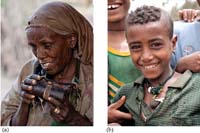
The way the community perceives or explains the causes of illnesses has a far-reaching effect on influencing people’s health-seeking behaviour and their choice of treatment options when deciding between modern or traditional treatment. Individuals or communities who think that illnesses are caused by naturalistic causes are more likely to choose modern treatment and attend for treatment at a hospital or health centre. Those individuals who perceive illnesses as having personalistic causes are more likely to choose traditional treatments such as holy water and go to see a traditional healer or a religious leader. As health educators your responsibilities will be to understand and identify the individual and community-level perceptions towards disease and educate people towards naturalistic explanations of the cause of illnesses, while being aware of their personalistic ideas.
Look back at the first question in Section 5.2 and note which beliefs listed as 1 to 5 you think are naturalistic and which are personalistic. Then summarise which of the explanations of the causes of illnesses assume that illness will be cured by scientific methods and which by supernatural cures?
In the previous question examples 3 and 4 were naturalistic and 1, 2, and 5 were personalistic. In your summary you should have noted that naturalistic beliefs are associated with scientific methods while personalistic beliefs are associated with supernatural cures.
5.3 The Health Belief Model
The Health Belief Model (HBM) is a model at the individual level that has been used to explain change and maintenance of health-related behaviours. You will be able to use it as a guiding framework for your health education work, especially during any health behaviour interventions.
The Health Belief Model has four major concepts. It assumes that people will take action to prevent or to control ill-health if they regard themselves as susceptible to the condition (perceived susceptibility). Also they will take action if they believe that the condition will have potentially serious consequences for them (perceived severity), and if they believe that the course of action available to them is beneficial in reducing their susceptibility to, or severity of, the condition (perceived benefits). They also need to believe that the anticipated barriers to taking the action are outweighed by its benefits (perceived barriers).
Think of an illness that you have experienced. Now using the questions below analyse your experience in terms of the Health Belief Model:
- Before developing the disease, had you ever thought that you were likely to develop the illness? (perceived susceptibility)
- Had you thought that the disease was severe with possibly serious complications? (perceived severity)
- Had you considered the benefits of getting treatment for the illness? (perceived benefits)
- Had you thought of any problems of accessing treatment for the disease? (perceived barriers)
Because the HBM is so closely based in individual experience it is easy to use it to think about illnesses we have had. Did you find that all four questions were easy to apply to your own experience of illness? Also, because it works so well as a way of thinking about our own experiences, going through the elements of the HBM should help us understand some of the influences on the health beliefs of other people in our community (Figure 5.3).
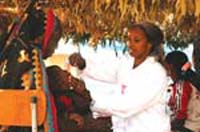
Before you move on, just check now that you know the assumption and the four major concepts that are central to the HBM?
The HBM assumes that the most important determinants of people’s behaviours are their beliefs or perceptions. There are four major concepts related to perceptions and beliefs: perceived susceptibility, perceived severity, perceived benefits and perceived barriers.
Let us consider this now in a practical context. According to the HBM, a young, single individual is most likely to attend for an HIV test if the following applies:
- If they believe that they are likely to get an HIV infection (perceived susceptibility)
- If they believe that HIV is a serious disease (perceived severity)
- If they believe that it is important to know their HIV status and also that this will help them to get other services such as medication (perceived benefits)
- If they also believe that they can get the HIV test for free and there are no major problems to get the test (perceived barriers).
Therefore if you are applying the HBM in designing health education sessions about the importance of HIV testing, your role as a health educator will be to teach people about:
- Their susceptibility to HIV infection
- The serious consequences and severity of HIV/AIDS
- The benefits of getting professional help.
Read the description above again, which sets out the HBM in relation to HIV/AIDS. Now consider the following situation. Assume that you are planning to educate Ato Abebe, a member of your community, on how to prevent malaria using a teaching session based on the Health Belief Model. How you would use the HBM to help you design your health education session?
If you want to apply the Health Belief Model in designing your health education session on preventing malaria, the first step will be to identify Ato Abebe’s personal beliefs according to the components and assumptions of the HBM.
You could ask Ato Abebe the following questions that are based on the HBM:
- Do you believe that you are susceptible to get malaria? (perceived susceptibility)
- Do you understand that malaria is a serious disease? (perceived severity)
- Do you think that going to a health centre for the diagnosis and treatment of malaria is important? (perceived benefits)
- Do you know that you can get malaria diagnosed and treated at the health centre? There should be no major problems for you to get the necessary services (perceived barriers).
Based on the answers that you get from Ato Abebe you can develop your health messages as follows:
- You are susceptible to get malaria infection
- Malaria is a serious disease
- Please go to a health centre for tests, and if you are found to have malaria take the medication that will be given to you
- You can get the medication for malaria at reasonable cost.
5.4 Theory of Diffusion of Innovations
Diffusion of Innovations is a theory of how, why, and at what rate new ideas and technology spread through cultures. This theory shows for example how the utilisation of insecticide treated bed nets (ITNs) could be disseminated in your community starting from one household, a model family, to the other households. The theory can help you find out how fast or how slow the dissemination was and why the innovation has spread to other households.
5.4.1 Five stages of the adoption process
Diffusion of an innovation is usually considered to occur through a five step process. The five stages (steps) in the adoption process are: knowledge, persuasion, decision, implementation and confirmation.
- Knowledge
During this stage the individual is first exposed to an innovation but lacks information about the innovation.
A sexually active adolescent called Ermias hears or is told about condoms for the first time, but doesn’t know much about the subject.
- Persuasion
At this stage the individual is interested in the innovation and actively seeks information and more details about the innovation.
Ermias becomes interested in condoms and tries to find out more information about condoms and how he should use them.
- Decision
In this stage the individual takes the concept of the innovation and weighs the advantages and disadvantages of using the innovation — and then decides whether to adopt or reject the innovation.
Based on the information he has found out about condoms and considering his own situation, Ermias has decided to use condoms.
- Implementation
During this stage the individual determines the usefulness of the innovation and may search for further information about it.
Ermias has used condoms and he has appreciated the usefulness of condoms for his own situation. There will be benefits for him if he continues to use them.
- Confirmation
In this stage the individual finalises their decision to continue using the innovation and may use the innovation to its fullest potential.
Ermias has made his final decision to use condoms always, consistently and correctly.
Remember that some young people might be reluctant to talk about issues to do with their sexual health and may need skilled help before they adopt safe practices such as condom use.
5.4.2 Rate of adoption
The rate of adoption is defined as the relative speed with which members of a social system adopt a new innovation. It is usually measured by the length of time required for a certain percentage of the members of that social system to adopt an innovation. In general individuals who first adopt an innovation require a shorter adoption period than late adopters.
There becomes a point at which an innovation reaches a ‘critical mass’. This is a point in time within the adoption process that sufficient individuals have adopted an innovation so that the continued adoption of the innovation becomes self-sustaining.
There are some strategies that help an innovation to become accepted (Figure 5.4). These include having an innovation adopted by respected individuals in your community. It is always helpful to introduce an innovation into a group of individuals who are ready to accept an innovation and who will provide positive reactions and benefits for early adopters of the innovation.
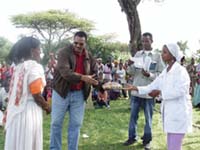
5.4.3 Adopter categories
Adopters are defined as categories of individuals within a social system on the basis of how innovative they are. The categories of adopters are usually considered to be innovators, early adopters, early majority, late majority and laggards.
- Innovators — innovators are the first individuals to adopt an innovation.
- Early adopters — this is the second fastest category of individuals who adopt an innovation.
- Early majority — individuals in this category adopt an innovation after a varying degree of time. This time of adoption is significantly longer than the innovators and early adopters.
- Late majority — individuals in this category will adopt an innovation after the average member of their society. These individuals approach an innovation with a high degree of scepticism and after the majority of their society has adopted the innovation.
- Laggards — individuals in this category are the last to adopt an innovation.
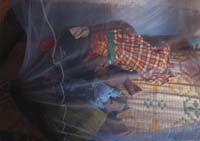
Before you go any further think about your own position as an adopter. Do you tend to be at the front of the crowd? Or are you last? Don’t limit yourself to health matters. Try to think more broadly.
People are different as we know! Although most people tend to be generally in one category or in overlapping categories it is possible to be a very different sort of adopter depending on their interests. For example, you may be an early adopter in relation to health, as clearly that is one of your passions. But perhaps you lag behind others when it comes to technology?
When it comes to innovation there is also one other category of person who is very important — opinion leaders. These are people in a given community who are influential in spreading either positive or negative information about an innovation.
Who are the usual opinion leaders in your community?
The opinion leaders in your community might be the leaders of the church or village elders or politically influential people. As a Health Extension Practitioner people might look to you to be an opinion leader also – especially about health issues.
Summary of Study Session 5
In Study Session 5 you have learned that:
- This session has helped you look at some of the ways that people consider health and illness. This will be important for your work in the community because understanding these theories and concepts will help you think more closely about your work and how people behave when they are ill.
- Understanding health behaviours is often the key to delivering health messages that are effective and that will improve the health of your community. This session has also discussed the importance of using theories and models in your health education activities.
- The naturalistic explanation is based on medical beliefs and assumes that illness is due to impersonal, mechanistic causes in nature that can be potentially understood and cured by using scientific methods.
- The personalistic explanation for the cause of illness is a traditional method in which illness is seen as being due to acts or wishes of other people or supernatural beings and forces.
- The Health Belief Model assumes that the most important determinants of people’s health-related behaviours are their beliefs and perceptions.
- Diffusion of Innovations is a theory of how, why, and at what rate new ideas and technology spread through cultures.
- An adopter category is a classification of individuals within a social system on the basis of innovativeness. A total of five categories of adopters are used: innovators, early adopters, early majority, late majority and laggards.
- Opinion leaders are personalities in a given community who are influential in spreading either positive or negative information about an innovation.
Self-Assessment Questions (SAQs) for Study Session 5
Now that you have completed this study session, you can assess how well you have achieved its Learning Outcomes by answering these questions. Write your answers in your Study Diary and discuss them with your Tutor at the next Study Support Meeting. You can check your answers with the Notes on the Self-Assessment Questions at the end of this Module.
Case Study 5.1 for SAQ 5.1
Wro Abebech, who is a mother of three children, is not feeling very well and she is complaining of fever and headache. Her husband and other family members are also worried about her health and they are supporting her by relieving her of her duties and by providing her with a better diet. After a while she was visited by a Health Extension Practitioner and referred to the nearby health centre for further management. In the health centre she was diagnosed by the nurse to have malaria and she received her treatment and then went back home. On her return she spent a week in bed with support from her family and neighbours. Soon after this she got better and returned to her day to day activities.
SAQ 5.1 (tests Learning Outcomes 5.1 and 5.2)
Based on the above case study, identify the specific phrases or words which clearly show the following states of ill health:
- a.Disease
- b.Illness
- c.Sickness.
Answer
According to the things you learnt in Study Session 5, disease is negative bodily occurrences as conceived of by the medical profession. Illness is negative bodily occurrences as conceived of by the person themself. Sickness is negative bodily occurrences as conceived of by the society and/or its institutions such as family members. Hence, based on the case study given in SAQ 5.1, the words or phrases corresponding to the three states of ill-health in Abebech are:
- a.Disease: ‘She was diagnosed by the nurse to have malaria and she received her treatment and then went back to her home’.
- b.Illness: ‘She is not feeling good and she is complaining of fever and headache’.
- c.Sickness: ‘Her husband and other family members are also worried about her status and they are supporting her through relieving her of her duties and by providing her a better diet. On her return she spent time in bed with support from her family and neighbours’.
Case Study 5.1 Sisay’s story
Sisay, a five-year-old child, is ill with measles and he has a fever, body rash and cough. He has been ill for the last three days and other young children are also sick in your community. His mother, who is not educated, says that his illness is due to an evil eye and she is suggesting that he should go to the Holy Spirit. Her major argument was that the other children have been managed in the same way. His father, a diploma holder and a government employee, says that Sisay’s illness is due to a pathological cause and he should visit the nearby health post. After a thorough discussion, and some argument on the issue, the father’s idea was outweighed and the child is taken to the nearby church.
SAQ 5.2 (tests Learning Outcomes 5.1 and 5.3)
Based on the above case study, try to answer the following:
- a.Whose explanation of the causes of the illness (measles), is naturalistic and whose is personalistic?
- b.Whose cause or explanation is correct? Mother’s or father’s?
- c.Do you think the final decision of taking the child to the nearby church is an appropriate measure?
- d.As a Health Extension Practitioner, what would be your responsibility in addressing this issue that involves misperceptions and inappropriate actions?
Answer
- a.The father’s explanation that measles is caused by a pathogen is naturalistic as it has some scientific basis and the mother’s belief that measles is caused by an evil eye is a traditional/non-scientific explanation and it is classified as personalistic.
- b.The father’s explanation of the naturalistic cause is the correct one as it is scientifically proven fact that measles is caused by an infectious agent.
- c.The final decision of taking the child to the nearby church was not an appropriate scientific measure as the decision was based on a traditional/non-scientific explanation as a cause for measles.
- d.As a Health Extension Practitioner, your responsibility in addressing the issues that involve misperceptions and inappropriate actions would be to identify peoples’ perception on the causes of illness; if you come across any kind of personalistic explanations, try to educate them about the scientific causes of the illnesses and persuade them to get scientific/modern treatments for those diseases which have proven scientific causes and cures.
SAQ 5.3 (tests Learning Outcome 5.4)
Suppose Demekech is a member in your community, who is a TB patient on anti-TB treatment and that she has a two-year-old boy. If you are planning to educate the mother about the importance of taking her child for a TB check to the nearest health centre, what kind of information and health messages based on her perceptions and the Health Belief Model could you use?
Answer
According to the case study Demekech is a TB patient who has a 2-year old child and she is on anti-TB treatment.
If you want to apply the Health Belief Model in designing your health education sessions, the first step will be to identify the mother’s personal beliefs according to the concepts and assumptions of the HBM. Then construct your health messages based on the perceptions you have identified.
You could ask the mother the following questions that are developed according to the HBM:
- Do you believe that your child is susceptible to get TB infection? (perceived susceptibility)
- Do you believe that TB is a serious disease? (perceived severity)
- Do you believe that taking the child to a health centre for TB diagnosis is important to know his status and also to get anti-TB treatment for your child if this is necessary? (perceived benefits)
- Do you believe that your child can get the diagnosis and treatment of TB for free and there are no major problems to get the treatment or other services? (perceived barriers)
Then based on the answers that you get from the mother you can develop your health messages as follows:
- Your child is susceptible to get TB infection
- TB is a serious disease
- Please, take your child to a health centre for TB diagnosis and if he is found to be infected make sure that he takes his anti-TB treatment
- Your child can get the TB diagnosis and treatment for free.
SAQ 5.4 (tests Learning Outcome 5.5)
Imagine that you are trying to disseminate information on the importance of the proper utilisation of insecticide treated bed nets (ITNs) in your community. If you are applying the theory of Diffusion of Innovations what kind of actions would you expect from a household headed by Ato Kedir in each of the following five stages of the Diffusion of Innovations?
- a.Knowledge
- b.Persuasion
- c.Decision
- d.Implementation
- e.Confirmation
Answer
If you are applying the theory of Diffusion of Innovations while designing your health education sessions for Ato Kedir and his family these might be the stages of the diffusion of innovations they are likely to be following:
- a.Knowledge: in this stage Ato Kedir and his family is exposed to an innovation but they lack information about the innovation. During this stage of the process they have not been inspired to find more information about the innovation.
- b.Persuasion: at this stage Ato Kedir and his family is interested in the innovation and actively seeks information and more details about the innovation.
- c.Decision: in this stage Ato Kedir and his family takes the concept of the innovation and they weigh the advantages and disadvantages of using the innovation — and whether to adopt or reject the innovation.
- d.Implementation: during this stage Ato Kedir and his family employs the innovation to a varying degree and they determine the usefulness of the innovation and then may search for further information about it.
- e.Confirmation: at this stage Ato Kedir and his family finalise their decision to continue using the innovation and may use the innovation to its fullest potential.
SAQ 5.5 (tests Learning Outcomes 5.1 and 5.5)
Suppose that you have planned and implemented health education programmes to disseminate information on the importance of the proper utilisation of ITNs in your community. Which of the community groups below are innovators, early adopters, early majority, late majority and laggards?
- a.Group I — started utilising ITN within the average time of diffusion
- b.Group II — first group of individuals to utilise ITN
- c.Group III — second fastest group to utilise ITN
- d.Group IV — the last group to utilise ITN
- e.Group V — started utilising ITN after the average members of the community had started to utilise ITN.
Answer
- a.Group I — started utilising ITN within the average time of diffusion — early adopters
- b.Group II — first group of individuals to utilise ITN — innovators
- c.Group III — second fastest group to utilise ITN — early majority
- d.Group IV — the last group to utilise ITN — laggards
- e.Group V — started utilising ITN after the average members of the community had started to utilise ITN — late majority.